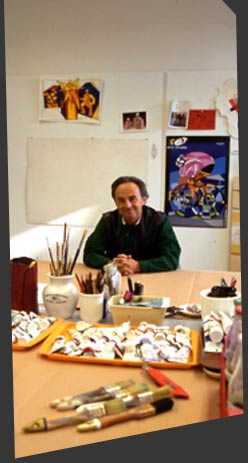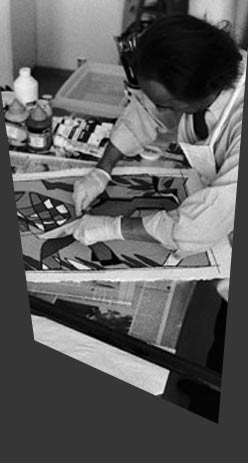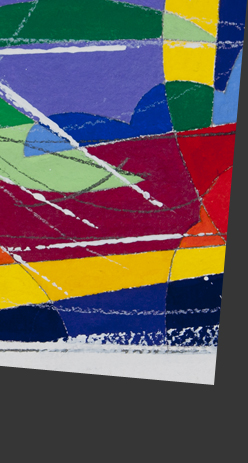CINEMA
FILM INSIDE AND OUT
Ugo Nespolo
FILM INSIDE AND OUT
I must say that "they" had already been working with "professional" seriousness (hateful word in that context) for some years at a task that to many appeared foolishly ambitious, or at least, naive and too easy.
I remember that during a lively evening Aristarco reassured everyone that he too knew how to do that type of cinema (like drinking a glass of water), forgetting that even my grandfather, on cold winter nights near the fireplace, used to tell me that he could have painted Matisse's paintings by telephone.
In the second half of the 1960's, American culture "invaded" the old world with its names like John, Jack, Bob, Roy, Andy, and so many others. It was paradise for our local xenophiles who were ready to accept  in toto  that which the greatest example of a policy of cultural exportation had to offer.
Thus, if the New American Cinema succeeded in imposing itself even outside the USA, it could do so thanks only to the dragging force of the late action-painting experiences, pop, and minimal beginning that in those years were being pushed even into the smallest provincial towns.
But "this cinema" has still always been considered the idiot child of the "great art"; a minor, degenerate child without any possibility of being accepted, rationalized, and above all, marketed.
Mekas spoke about the capillary distribution circuits that NAC had in the States to someone, like me, who dreamed of seeing something like an "Italian Independent Cinema" be born, a similar capillary distribution able to move - even always at an under - ground level - those films that some film makers were already realizing. But you have to come to grips always, and in any case, with the market.
We were in only a few, and for the most part broke (even though the cost of our "films" was low, it was always considerable). We were ignored by everybody, and especially by the critics who have always considered this cinema an amateurish by-product of and for frustrated persons. We did not even have the material possibility of showing the results of our work, if not in the usual ghettos made up of art galleries, or the very few enlightened public places excluded by the market, which has never know how to handle this abnormal toad. So, we scattered, disappeared, tired of a struggle without meaning and satisfaction.
Now, who knows why or how, someone tells me that the "market" and the critics too, have noticed the film makers.
I have my doubts and my fears.
The sad image of the approaching birth of hoards of interested scholars immediately came to my mind; sages who will paraphrase the market of figurative arts and wind up deciding for us, and will also tell us what we should do, from season to season without even apologizing for the long delay.
A few words about my movies.
I left with my 16 mm Bell and Howell equipped with an Angenieux Zoom in search of cinema, and I was lucky.
"My characters" worked with dexterity. Right off, Baj sprang rapidly in front of the camera, and with consummate skill waved tricolored flags on the fields in the company of the wise (and patient) Lucio Fontana, to attempt with the help of Volpini, an improbable, small, Lombard sentinel. I was thinking then of a sort of "photo-graphed theater", full of improvisation and bizarre materials. The idea was to land in a magical territory, in everlasting, untiring movement, in short, a game where rationality was banished to make room for a free associationistic creation, sounds and images, movement and color, sense and non sense.
La galante avventura del cavaliere dal lieto volto, and earlier still, Grazie mamma Kodak had no other roots if not this.
But deep down, I've always tried to follow a "critical" course.
With fatigue, I've searched for the grimace, the slap, acidity and sarcasm, all barely tinted with humor and a good play, good workmanship and guaranteed amusement.
All the characters move like small toys, now docile, now strange, crazened robots in actions without sense.
Their movements, in fact, are all mechanical, carefully accelerated to the excess, frenetic and nervous, as untiring as they are useless.
Thus, the critical course I spoke about before stretched out ahead, obliquely, readable with a smile on my lips.
I'm thinking of Buongiorno, Michelangelo, for example, which could be attributed to an early Polanski-esque idea. This enormous paper ball that rolls along the streets of a cold Turin, all squared off and in grisaille, becomes a symbolic object of absurd provocation that may also be read as a vacuous, goliardic exhibition. The fact is that the "foreign element" maliciously inserts itself in any landscape of the city, and among the people that look on dismayed, without understanding. Pistoletto pushes the ball and the people follow him to see "how much" or "why". And if the ball becomes an enormous rose at the end, then we are in unjustified folly.... but they' re only hypotheses. No one lets himself be overwhelmed or provoked anymore. The hide is thick and serves as a defense. Surrealism has nothing to do with it, in no way; instead its a question of reading reality even in its paradoxical, internal, at times unexplainable aspects.
But the true reading is done with a "critical eye". A small meanness is added without pity to the interpretation of things: the Polaroid photos in Con-certo Rituale, Beuys head in Un Supermaschio, the electronic culture in Andare a Roma.
My films are based on excess, on "more", on "supplementary information", a sort of home-made acculturation with movable contours.
But theories are only theories, and leave things unchanged.
And then, they' re static like words, cold and false.
The images on the screen move on without tiring, they' re immodest, they don't fear the critics because they trust no one, they really and only try to make even the blind and deaf understand that every him maker is independent at heart. [1976]
FILM INSIDE AND OUT
Every filmmaker is independent at heart
Stan Brakhage
For us, there is only the trying, the rest is not our business
T. S. Eliot
I must say that "they" had already been working with "professional" seriousness (hateful word in that context) for some years at a task that to many appeared foolishly ambitious, or at least, naive and too easy.
I remember that during a lively evening Aristarco reassured everyone that he too knew how to do that type of cinema (like drinking a glass of water), forgetting that even my grandfather, on cold winter nights near the fireplace, used to tell me that he could have painted Matisse's paintings by telephone.
In the second half of the 1960's, American culture "invaded" the old world with its names like John, Jack, Bob, Roy, Andy, and so many others. It was paradise for our local xenophiles who were ready to accept  in toto  that which the greatest example of a policy of cultural exportation had to offer.
Thus, if the New American Cinema succeeded in imposing itself even outside the USA, it could do so thanks only to the dragging force of the late action-painting experiences, pop, and minimal beginning that in those years were being pushed even into the smallest provincial towns.
But "this cinema" has still always been considered the idiot child of the "great art"; a minor, degenerate child without any possibility of being accepted, rationalized, and above all, marketed.
Mekas spoke about the capillary distribution circuits that NAC had in the States to someone, like me, who dreamed of seeing something like an "Italian Independent Cinema" be born, a similar capillary distribution able to move - even always at an under - ground level - those films that some film makers were already realizing. But you have to come to grips always, and in any case, with the market.
We were in only a few, and for the most part broke (even though the cost of our "films" was low, it was always considerable). We were ignored by everybody, and especially by the critics who have always considered this cinema an amateurish by-product of and for frustrated persons. We did not even have the material possibility of showing the results of our work, if not in the usual ghettos made up of art galleries, or the very few enlightened public places excluded by the market, which has never know how to handle this abnormal toad. So, we scattered, disappeared, tired of a struggle without meaning and satisfaction.
Now, who knows why or how, someone tells me that the "market" and the critics too, have noticed the film makers.
I have my doubts and my fears.
The sad image of the approaching birth of hoards of interested scholars immediately came to my mind; sages who will paraphrase the market of figurative arts and wind up deciding for us, and will also tell us what we should do, from season to season without even apologizing for the long delay.
A few words about my movies.
I left with my 16 mm Bell and Howell equipped with an Angenieux Zoom in search of cinema, and I was lucky.
"My characters" worked with dexterity. Right off, Baj sprang rapidly in front of the camera, and with consummate skill waved tricolored flags on the fields in the company of the wise (and patient) Lucio Fontana, to attempt with the help of Volpini, an improbable, small, Lombard sentinel. I was thinking then of a sort of "photo-graphed theater", full of improvisation and bizarre materials. The idea was to land in a magical territory, in everlasting, untiring movement, in short, a game where rationality was banished to make room for a free associationistic creation, sounds and images, movement and color, sense and non sense.
La galante avventura del cavaliere dal lieto volto, and earlier still, Grazie mamma Kodak had no other roots if not this.
But deep down, I've always tried to follow a "critical" course.
With fatigue, I've searched for the grimace, the slap, acidity and sarcasm, all barely tinted with humor and a good play, good workmanship and guaranteed amusement.
All the characters move like small toys, now docile, now strange, crazened robots in actions without sense.
Their movements, in fact, are all mechanical, carefully accelerated to the excess, frenetic and nervous, as untiring as they are useless.
Thus, the critical course I spoke about before stretched out ahead, obliquely, readable with a smile on my lips.
I'm thinking of Buongiorno, Michelangelo, for example, which could be attributed to an early Polanski-esque idea. This enormous paper ball that rolls along the streets of a cold Turin, all squared off and in grisaille, becomes a symbolic object of absurd provocation that may also be read as a vacuous, goliardic exhibition. The fact is that the "foreign element" maliciously inserts itself in any landscape of the city, and among the people that look on dismayed, without understanding. Pistoletto pushes the ball and the people follow him to see "how much" or "why". And if the ball becomes an enormous rose at the end, then we are in unjustified folly.... but they' re only hypotheses. No one lets himself be overwhelmed or provoked anymore. The hide is thick and serves as a defense. Surrealism has nothing to do with it, in no way; instead its a question of reading reality even in its paradoxical, internal, at times unexplainable aspects.
But the true reading is done with a "critical eye". A small meanness is added without pity to the interpretation of things: the Polaroid photos in Con-certo Rituale, Beuys head in Un Supermaschio, the electronic culture in Andare a Roma.
My films are based on excess, on "more", on "supplementary information", a sort of home-made acculturation with movable contours.
But theories are only theories, and leave things unchanged.
And then, they' re static like words, cold and false.
The images on the screen move on without tiring, they' re immodest, they don't fear the critics because they trust no one, they really and only try to make even the blind and deaf understand that every him maker is independent at heart. [1976]




